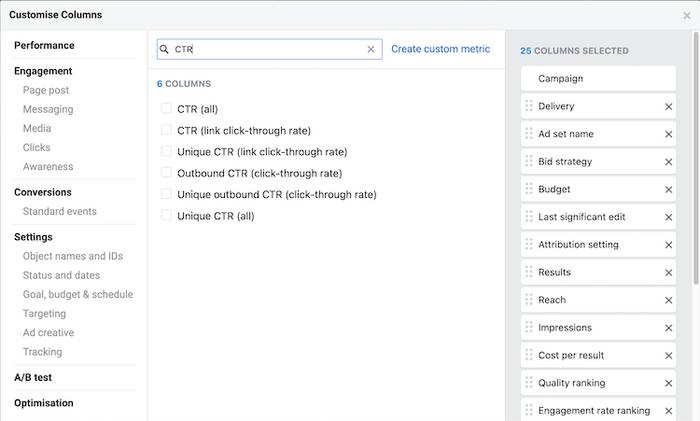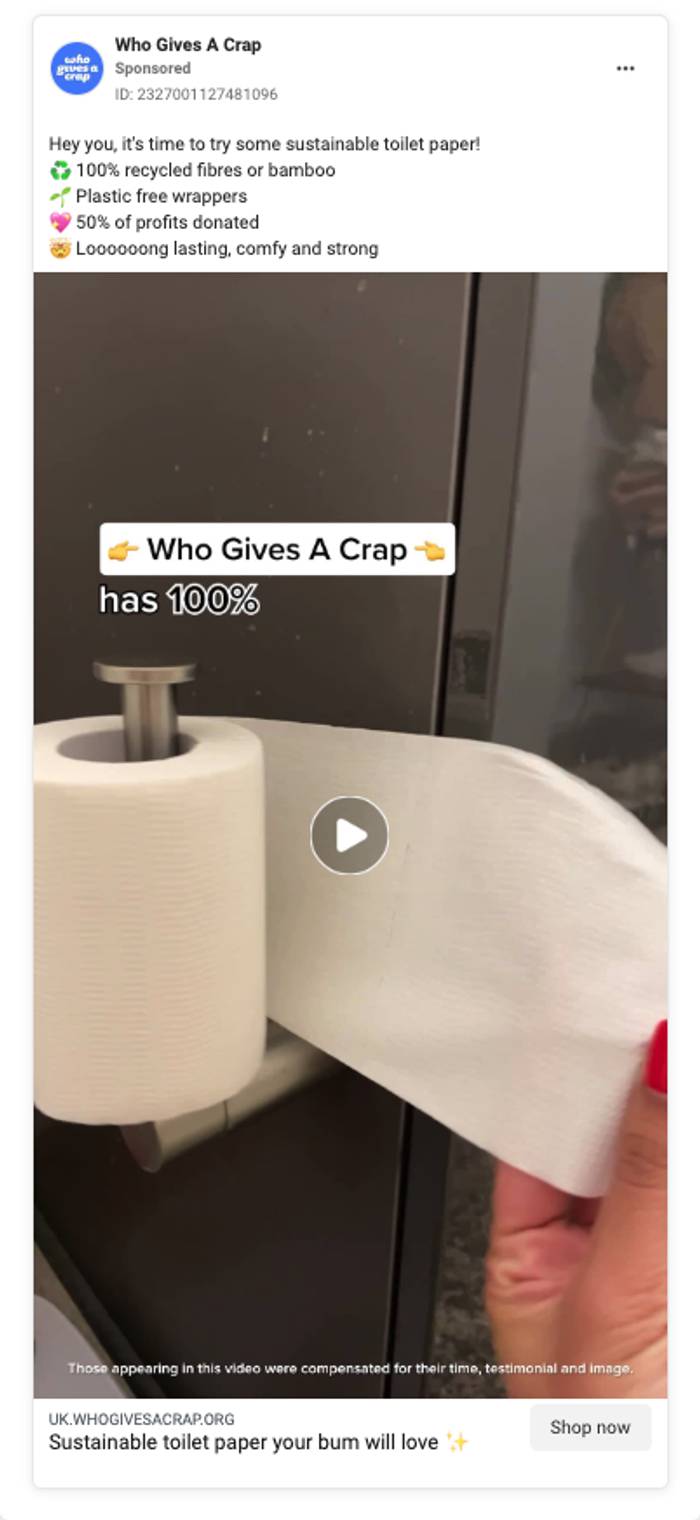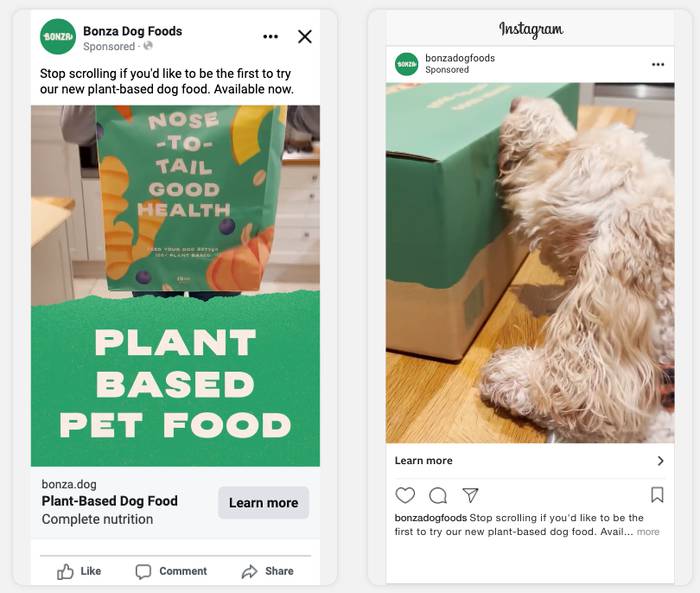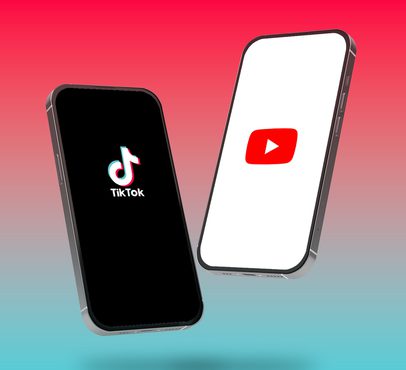If you’re running a business, paying for marketing or a marketer yourself, you’ll know the endless quest that is trying to ensure you can demonstrate return on your spend.
We always want to know that what we're paying for (or investing time in) is working. Click-through rate (CTR) is a key metric for proving how well you’re engaging your audience across multiple channels and platforms.
What is click-through rate (CTR)?
CTR is a digital marketing performance metric that looks at how well your content gets people from one place to another. It can apply to your search engine results, email campaigns, social media ads and paid search activity.
There are some variations on what constitutes a CTR and as such, you might notice some platforms, like Meta, have slightly different options - for example, you’ll see outbound CTR (all) vs CTR (link click-through rate). This is because CTR within Meta could also include a number of different types of clicks, including:
Link clicks
Clicks to the associated business Page profile or profile picture
Post reactions (such as likes or loves)
Comments or shares
Clicks to expand media (such as photos) to full screen
Clicks to take actions identified as your campaign objective (such as liking your Page for a Page engagement campaign)
How is click-through rate calculated?
CTR is usually expressed as a ratio of the number of times something was clicked to the number of times it was shown (an impression). So, clicks ÷ impressions = CTR. 8 clicks from 100 views means a CTR of 8%.
By digital marketing channel, this might look like:
Paid media: Total clicks on an ad ÷ by total impressions, multiplied by 100.
Email: Total clicks through to your content within an email (not opens!) ÷ by total delivered messages.
Organic search: The number of clicks a search result receives, divided by the number of times it's viewed on the SERP (also known as ‘impressions’).
Why is click-through rate important?
A good CTR means you're doing a good job at giving your audiences what they want and are interested in. CTR is a marker of quality and relevance for the things you are creating; it’s an indicator that you’re resonating with your target audience.
Analysing your CTR is important on a secondary level as it can reveal what’s working in the real world; it shows what might be able to be replicated for further success, or what can be improved upon.
What makes CTR particularly important in the current marketing climate is the fact that as a metric it is calculated within the platform you’re using. In the wake of various privacy changes, tracking the impact and success of your marketing has become markedly more difficult.
When utilising the CTR data from within a platform, there is less reliance on third-party data, so you can have a greater level of trust in those figures.
Click-through rates by digital marketing channel: what’s ‘good’?
It is important to note that the basis for a ‘good’ CTR will vary depending on the industry, product or service as well as the quality of the creative and execution. These variables mean there is no one set rule for a good CTR, but there are some averages we can provide as a guide.
What is a good CTR for social media advertising?
Social platforms vary even within themselves, but we would advise that anything above 1% is a solid CTR for your social media ads. However, at Extreme, we have seen higher performing creatives exceed CTR of 5 or 6% - this goes to show the importance of investing in high impact content and creative. Other factors also include the level of familiarity with your brand, past purchases, brand trust and loyalty.
What is a good CTR for pay-per-click advertising?
Again, it is crucial here to allow for fluctuation based on industry, the average CTR for search ads is 3.17%. However, it is important to differentiate between brand and non-brand campaigns.
If you are bidding on your brand’s name as part of your paid search activity, you can expect the average CTR to be significantly higher. Users exposed to the ads in this campaign have already performed any necessary research and have made the decision to purchase from or engage with your company. A low CTR at this point would be extremely concerning and would beg the question - who are you losing out to?
On the display network the average CTR is much lower, sitting around 0.46%. This makes sense: if a user has actively searched for your product or service, they are demonstrating an active intent to purchase, enquire or find out more about the subject. A display ad on the other hand, appears to the user when they are not necessarily in that same mindset, so a click is a bigger ask.
What is a good CTR for my email marketing campaigns?
Low though it may sound, you should be happy with something in the 3% region; anything higher should be considered very good. Note that CTR differs from your open rate - CTR in email is when a user navigates towards the resource you’re directing them to within the email; typically something on your own website.
As with many of these marketing channels, there are a huge number of ways you can help manage and direct this. We are all awash with marketing emails, so yours need to be geared to your audiences, factoring in a strong hook, quality, well-written content and ensuring maximum relevance. More on this later.
What is a good CTR for organic search results?
Given the variety of search engine results page (SERP) features, there are so many factors that make it difficult to nail down a ‘good’ CTR. User search intent also plays a huge role; results appearing for brand-based searches will naturally yield the highest CTA compared to those where the user is conducting research.
What also muddies the water further, is that the CTR is influenced by the position you appear in the search results. A recent study of 1,312,881 pages and 12,166,560 search queries revealed that the number one position has an average CTR of 26.7%. It is 10 times more likely to receive a click when compared to the 10th result. On average, moving up by one position will see your CTR increase by 2.8%.
What can impact and affect click-through rate?
CTR is not a done deal. What you get is not just what you get based on industry averages; there are certain things you can do to ensure you maximise your chances of success, ranging from content changes to audience targeting.
Brand recognition
This is a big one. Naturally, if a consumer has bought from you before, or even just heard of you, then there’s a greater chance they will pay a greater degree of attention to your content. That doesn't mean you can be complacent; rather it stresses the importance of consistently developing your brand equity among your audiences.
We recently learned in a webinar from Meta that 28% of sales impact is driven by long-term brand factors. That’s according to a survey they commissioned, Global CPG Execution Practices to Maximise Meta Performance.
This requires being present, having a unique proposition, focusing on what your audiences need and want and working within your purpose and values to build emotional and long-term connection with your consumers.
A clear brand strategy is essential to long-term success and return.
Content quality
This goes for all types of content. It should go without saying, but begs repeating that content is king. What you say and how you say it are intrinsically linked to the performance of your blog, emails, and the same for video too.
When generating content, your aim should always be to provide something that someone else isn’t or cannot — or produce a better version than them. You are seeking to stop the scroll, answer the key question, grab attention or provide assistance and benefit.
Creativity
Is your imagery and creative content engaging, disruptive and interesting? If you ask yourself this honestly and the answer to any of these is ‘no’ or ‘I think so’ rather than a resounding ‘yes’, then it’s important to revisit your creative assets. You have very minimal time to stop the scroll, so don’t keep creating the same as everyone else and expecting different results.
Audience targeting
Are you reaching the right people? Yes, targeting has become more challenging in the light of privacy changes, but it is important you are still focused on doing what you can to reach the right audiences. We talked more about this in our guide to privacy and tracking.
Your call-to-action
When you’re creating a piece of content, email or an ad, you need to be clear on its purpose and what you expect the consumer to do next. Without this direction, or call to action (CTA), you are likely to be disappointed in the results as your audiences may consume but fail to follow on, engage or respond.
Context
As well as being clear about what it is you’re asking for, are you being ‘aware’ while you do it? By this we mean, does it make sense? Does it have context? Are you aware of the location, time and even the socio-economic factors impacting your audiences?
Now, we are not suggesting you can tailor your content to meet the individual needs of every audience member, but successful brands are focused on context in the ways in which they can be.
For example, if it’s the end of the month, people may be spending less as they await payday, or they may appreciate the opportunity to spread payments with a scheme such as Klarna - this is context.
Competition
Be aware of who and what you are up against. Clearly, if your competition is more appealing, you’ll stand to lose out.
Whilst a worthy consideration for all channels, this is particularly relevant for organic search. Who else is appearing and where in search engine results pages? How are they pitching that information?
You need to be watching and tweaking to ensure your results remain the most appealing version, so it can compete and hopefully outperform the rest. We’ll touch on a number of ways you can make your brand’s search results more appealing just later on.
Intent
It’s important to consider that brand-based searches are naturally going to have a higher CTR than broader, research-based searches.
Let’s say you’re a popular brand of household vacuum cleaner. More specifically, one sporting a smiley face. You’ll receive a higher CTR for the search ‘henry vacuum cleaner’ compared to ‘vacuum cleaners’.
Platforms themselves
This is particularly relevant to social media, but traditionally, over the years most platforms want to keep users ‘in’. This means you still can’t click out from Instagram feed posts and TikToks - something to be mindful of.
Google has also made huge efforts to promote ‘zero click searches’ - where a user receives all the information to satisfy their query just on the results page. The more Google promotes zero click searches, the less clicking that goes on, lowering your CTR!
It is important not just to know what can impact CTR, but how to navigate through that and actually improve your CTR.
How to improve your click-through rate
You can (almost immediately) improve your CTR by:
Knowing your audience: this means what they want - think discounts, loyalty schemes, more time, freedom - and then find a way to help them get it. Sense check that you’re relevant to their needs and wants.
Maintain a consistent brand presence: remember that not everyone is ready to buy from you right now, so sales-y content at the research stage will deliver a lower CTR.
Build on your existing audience: there’s a much wider audience who could benefit from your product or service, but in order to resonate with them, you’re going to need to know what problem they want to solve.
Add a sense of urgency (where applicable): this is so users don’t delay in clicking, or think they can come back later. Think limited time only offers, deals, reveals, first looks and exclusive content.
Include trust signals: wherever possible, social proof, reviews, industry accreditations and experts can reassure and entice your customers, showing them why they should pick you over the rest.
Those are some of the more general things you need to think of, but what about my individual marketing channels we hear you cry? Fear not, the team of experts here at extreme has put together a breakdown of just how to level-up your CTR, no matter how you’re marketing.
How to improve your social media advertising CTR
Getting more people clicking your social ads can be as simple as discovering a good hook and ensuring your creative assets look on point. Tailoring the copy for your customer’s journey will help, too!
Include a good hook/headline
A good hook is non-negotiable. With all of your marketing content you are aiming to stop the user in their tracks and, in this case, stop the scroll. Show them something that’s interesting, different and benefits them — as done excellently by Who Gives A Crap.
Tailor the copy
Be aware of where you are on that customer’s journey. By this we mean, if it’s a completely cold prospecting audience in a Meta campaign, you’ll want to include certain details that you could omit from audiences that know you a little better i.e. retargeting and existing customers.
Choose the right objective
No point measuring success on CTR if your strategy doesn’t lean into this metric.
For example, if your objective is to drive people to a destination (usually your website) then measuring the CTR as part of your overall performance can tell you if your content is resonating with your target audience at that moment in time.
However, if you’re running an awareness-style campaign with the ‘reach’ or ‘video views’ objective on platforms like Meta, they will optimise to show your advert to as many people as possible or get as many video views for your budget - not getting people to click through to your site.
When analysing an awareness campaign like this, CTR can still be a useful metric for reporting on further action taken. But if the advert isn’t intended to drive people to a destination, then the CTR is likely to be lower compared to a traffic or remarketing campaign, where the CTR is typically higher. This is because the campaign will be optimised to get as many clicks or sales via your website as possible for your budget.
Get the creative right
Generally speaking, creative is responsible for 50% of the sales impact and 54% of the return on ad spend of Meta ads, which is why it’s so important - in addition to spend and strategy (according to Nielsen analysis commissioned by Meta). We've written an entire blog about how to ensure your social ad creative is on point!
Consider placements
Be aware that some placements naturally have a better opportunity for higher click through rates. This is due a number of factors: how popular they are with users; user behaviour; context and platform functionality.
For example, in our experience, Meta ads using the mobile news feed placement tend to have considerably higher CTRs when compared to the right column placement - generally speaking. Studies back this up: CTR from Facebook in the newsfeed is 1.11%, compared to just 0.16% for right-side placements.
Don’t forget about static formats
While video has exploded on social platforms, the right static creative can still perform really well and stand out in a sea of video content.
How to improve your pay-per-click advertising CTR
Search ads are another fantastic way to increase visibility, but it is important that you manage your ads, test, keep them updated and pay attention to the changing needs of your consumers on their purchase journey. Also, be sure to make the most of all available ad extensions.
Use all available ad extensions
Sitelink extensions, price extensions and image extensions and more all allow you to take up more of the SERP real estate and help your ads to stand out compared to competitors’ ads.
Revisit and re-analyse search terms
Go back and keep an eye on search terms that have triggered your ads to learn more about what your prospective clients or customers are searching for. Create new ad groups and ads based on your findings to make your ads as relevant as possible.
Test, test, test
Don’t just set and forget your ad copy. Implement a strategy of regularly testing different ad text and images. You can test everything from the call to action to the USPs you are highlighting. This will help you to discover what messaging resonates with your target audience.
How to improve CTR for organic search
The most important elements for CTR in search engines are creating concise, targeted title tags and enticing meta descriptions. More advanced techniques for making your search result stand out on the page include reflecting the search query in the URL and employing appropriate use of structured data.
If you’re looking to find your CTR data, the best place is under ‘Search Results’ in the ‘Performance’ tab in Google Search Console. Here you can filter the results to show individual pages and specific search queries. It is important to note though, that optimising for an improved CTR isn’t recommended for results that don’t appear on page one.
Focus on creating concise title tags
These should have a character limit between 40 and 60 that address search intent to maximise your CTR. Title tags that are lengthy, over optimised and lack relevance will negatively impact your CTR and could be rewritten by Google.
Refine your meta descriptions
Meta descriptions are the excerpts of text that appear underneath the heading in search results. They provide a short summary of the page and should ideally be no longer than 155 characters.
Although they’re not a ranking factor, meta descriptions play a key role in informing users about the page and enticing them to click - so they’re essential for your organic search CTR.
As well as trying to pique your audience’s interest with well-crafted, enticing copy, be sure to include the keywords from your title tag in the meta description. These terms will be bolded, and hence your result will be seen as more relevant to users.
Meta descriptions that don’t contain the key phrases that a page is optimised for may be seen as less relevant to users and could be rewritten by Google.
The tone you decide to use can also impact your CTR. Be sure to use positive rather than a negative or neutral sentiment.
Highlight the key features and benefits you provide
If you can do the above while conveying what makes your content unique, you will stand out from your competitors and therefore boost your CTR.
Analyse the search results
One key way you can stand out is to construct a counter narrative to stand out against your competitors. Saying exactly the same thing will only make you blend in, so it is important to seek out ways to differentiate your content.
Make a link between URL structure and the search query
A logical journey between these elements and the content that the page provides will make your search result appear more enticing and click worthy.
For example, this page (example.com/improve-your-click-through-rate) is more descriptive than (example.com/marketing/ctr). By making users more likely to trust that they’ll get the answer or information they want, you’re more likely to be the search result that is clicked.
Employ structured data
By adding richer information such as reviews, you can enhance your organic results. The more relevant and more useful information and data you can use, the better.
How to improve your email marketing CTR
There are a few components to crafting an engaging campaign: for securing those opens, the subject line and preview text. For converting these into clicks, enticing body copy, button text and imagery. Segmenting your audiences can also help to optimise CTR too, ensuring the right recipients get the content that matters to them most.
Open rates and CTR are relatively simple to measure through most email marketing platforms. It’s easy to see which of your recipients you’ve succeeded in engaging through your campaigns.
Craft short, snappy subject lines and preview text
Without people opening your email, you won’t get the click. So, it’s also important to consider tips and tricks to boost open rates.
The email subject line and preview text should capture the user’s attention and entice them to see what’s contained within. But, there are a few important things to consider. Subject lines should be no more than 6–8 words, as most people use mobile phones, which can cause overly-lengthy subject lines and preview texts to be truncated.
Consider using language that inspires action, or poses questions — ‘check out’; ‘discover’; ‘don’t miss’; ‘are you?’. Although it might feel ‘spammy’, it works.

If you’re having trouble and need a few actionable tips for analysing and optimising your subject lines, Omnisend’s subject line tester is a useful resource.
Personalise your emails
Make it appear as though you’re only talking to one person. A really simple way to do this is to use the first name code in your subject lines, preview text, header and body copy to grab your recipients’ attention.
This differs by email platform; in MailChimp, it’s *|FNAME|*. In Klaviyo, it’s {{ first_name|default:'' }}. Don’t overdo it, though, and make sure the first names are accurate and not misspelt in your email marketing platform.
Segment your email audiences
Make sure the content itself is personal to the reader. Improving your CTR means delivering your content to people who find it most interesting. Can your subscriber base be segmented into certain audiences? Perhaps you sell both B2B and B2C; that’s an obvious one. If you run a holiday park, then you might have subscribers who booked certain types of holiday.
Tease your content with compelling body copy
A ‘click’ through email is measured as having users navigate to a resource — usually your website — from a button. So, it goes without saying that you need to incentivise and engage your audience through the email body copy.
Get your readers excited about what’s contained in the article or landing page you’re directing them to; ignite their interest with some interesting teaser stats or questions that are answered within your resource. A little bit of ‘FOMO’ never went amiss, either.
Avoids walls of text. Paragraphs should be no longer than three sentences. All images should be relevant and of an appropriate resolution. Make sure your call-to-action is clear and concise, too. Avoid the default copy at all costs, like ‘click here’ or ‘learn more’.
Do some A/B testing
A/B testing allows you to take a look at two variations of an email and evaluate the impact of small changes. For example, have you got two incredible subject lines but you’re not sure which is the knockout? Split testing your emails allows you to try different combinations and see what works best for your subscribers, helping you to create future campaigns that drive higher CTR.
Optimise your email design
There’s nothing worse than a cluttered, over-designed email. Not only can it put users off, but it might not display appropriately on different devices. Develop one or two smart, responsive and on-brand email templates. Not only will it make it simple for users to consume what’s within, but each one will look distinctly ‘you’, helping to reinforce your brand.
Send your emails at the right time
Unsurprisingly, an email that lands at 04:00 is going to receive less immediate engagement than one that arrives on your desk mid-morning. Emails at wild times can even make them seem as if they’re intended for audiences in other timezones, too.
Any time during the work day is usually a safe bet; most email platforms allow you to send at a certain time in a timezone. You might like to split test your send times to get a clear idea of what works best.
Ready to become a click-through king (or queen)?
If CTR in 2023 is hurting your brain and you need some help getting the results you’re after, then it sounds like you need to drop us a line. Use the button below or head over to our contact page!
Let's get your customers clicking like never before.
Get in touchPost by

Since forming Extreme’s social media department back in 2012, our Head of Social Donna and her team’s work has been recognised nationally. With extensive experience spanning mutiple sectors, Donna specialises in social strategy, ideation and paid social advertising.
Project
Post by

Our SEO Lead with over 15 years’ experience, James calls on an extensive knowledge of search and works closely with our content team to deliver targeted, results-driven SEO strategies.
Project
Post by

Lucie is our lead on all paid media activity, overseeing our talented paid media team and managing the strategy and implementation of all paid search campaigns across multiple platforms. Fully Google qualified and working directly at Google prior to joining Extreme, there's not much Lucie doesn't know about PPC!
Project
Post by

Johnny bridges our content and SEO teams, creating and managing strategies that elevate clients' organic search visibility.
Project











